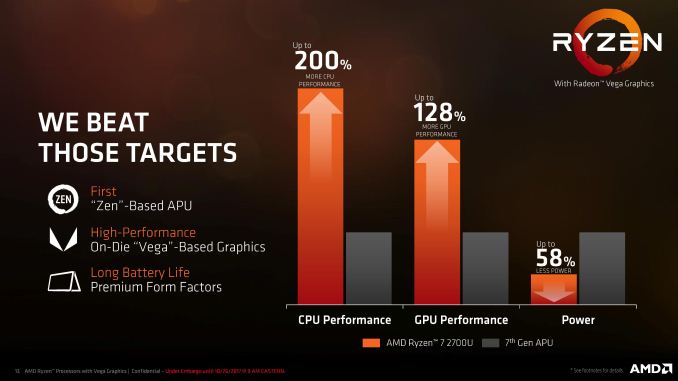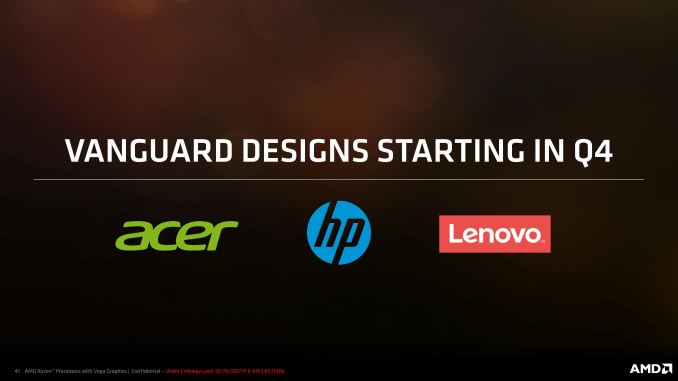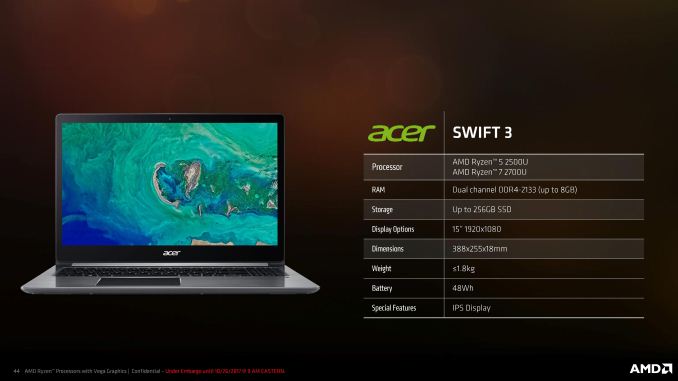Ryzen Mobile is Launched: AMD APUs for Laptops, with Vega and Updated Zen
by Ian Cutress on October 26, 2017 9:00 AM ESTAMD Ryzen Mobile: Zen 1.5
During our pre-briefings on Ryzen Mobile, it was asked why the two new APUs were using the 2000-series numbers, and not the 1000-series numbers like the desktop parts. It was assumed by the press that the first generation of Ryzen would all be under the 1000-series, including the mobile parts. The response given by Kevin Lensing, AMD’s Corporate VP of the Client Business Unit, was that so many of the design ideas that AMD wanted to put into the original desktop Ryzen (but couldn’t due to time) eventually ended up in Ryzen Mobile, such as the updated precision boost. While there are no architectural changes to Zen to warrant a next-generation microarchitecture name, this version of Ryzen’s periphery (i.e. the power) was more in-line with an original vision and had to be presented as such. This is why we have Ryzen 7 2700U, rather than a Ryzen 7 1700U. He would not comment if the true next generation Ryzen desktop naming would still be the 2000 series, or if we would go straight to 3000. Who knows, it might alternate.
The state of Zen aside, AMD’s return to high-performance computing with the Zen core was naturally going to trickle down into the notebook space. The question everyone asked is if such a high-power, high-performance core was going to make it in such a small power envelope: especially when you add some big graphics core next to it. In our desktop Ryzen reviews, we saw per-core power go as low as 8W per core, and AMD’s Vega was power hungry – promising to put four cores and some graphics into a single piece of silicon with a 15W TDP sounded harder than an uphill task, almost Sisyphean in nature. AMD has approached that by taking new methods to its power topology, how it manages that power, and found a combination of frequencies and performance that tally up to that 15W mark. They have also worked closely with the first three OEMs that are launching systems today to ensure a good user experience.
For performance, Ryzen Mobile has four cores with multithreading, with frequencies up to 3.8 GHz. This should give the mobile processor enough grunt under the hood in the 15W envelope to cater for a significant number of demanding workloads. GPU performance is also up, with AMD also hoping to push the hardware into a number of gaming-focused devices with FreeSync panels in the new few months. AMD is also touting significant power reductions during high-load tasks, leading to a 270% performance per watt improvement. More impressive is the steps taken towards how the processor manages power between cores and the GPU: a very complex implementation hopefully leading to a better power profile and 15-30% better battery life than previous generations for common use cases.
For the launch, AMD has partnered with HP, Acer and Lenovo for systems to go on shelves. As I am currently writing this, only HP provided any information about their upcoming systems and we’re likely to scramble when the other press releases come out. None of the three designs are ultimate eye-catching flagships, but rather approaching that middle-range $600-$1000 notebook territory with 13.3 inch 4K displays, up to 1TB SSDs, 48-55Wh batteries, and a device or two that can flip into a tablet. When we played briefly with the Acer unit in our pre-briefing, there was no lag – a user would be hard-pressed to immediately see a difference to a comparative Intel system.
Ultimately AMD has several very hard tasks ahead of it for Ryzen Mobile. Firstly it has to re-educate the sales teams at brick and mortar stores like Best Buy, who have only ever seen AMD has the low-cost budget option. If they still think the same way when Ryzen Mobile comes to town, they won’t be recommending them.
Second, they have to educate the public – after years of miserable user experiences leading to negative feedback loops, AMD has to convince these users that it is worth looking at AMD-powered devices again and there isn’t some sort of catch. Part of this solution will be in how well AMD integrates itself into the OEM sampling strategy for reviews, and if any reviewers are going to get devices this time around.
Third, AMD is several steps behind Intel in its marketing message: while Intel is trying to explain new ways to use the hardware (such as the failed ‘PC Does Whaaat?’ campaign almost a couple of years ago to the day), AMD is on the ‘I’m here too, and I’m just as good’ message. Back when we analyzed the Carrizo user experience, one thing we pointed out is that with most Intel flagships, most users do not even know what processor is inside – to these customers, saying ‘I’m just as good’ might give the impression ‘well what was wrong before?’. It might take AMD a round of flagships and XPS 13 or Zenbook Infinity-type designs to get the attention on their side of the discussion.
We have reached out to all three of the main OEMs who have Ryzen Mobile systems being announced today, but only one responded in time. This doesn’t bode well for any sampling, but we’re sitting here with a megaphone until we get one. Stay Tuned.
As part of this launch, AMD also discussed its progress towards its 25x20 goal, and AMD actually provided some data on how they are calculating this. We analyzed what AMD still has to do in a separate article, and you can read about it here:
http://www.anandtech.com/show/11965/amds-progress-on-its-25x20-goal-the-task-ahead














140 Comments
View All Comments
neblogai - Friday, October 27, 2017 - link
Still, it is HP that is the worst here. Lenovo is light ultra portable, small dimentions at 15W- not meant/able to do gaming anyway. Ram is soldered same like on it's Intels 'APUs'. Acer Swift- configured with 25W cooling(so should get mXFR certification) and dual channel, IPS, SSD- and not heavy. Good specs and can do gaming. But HP- the heaviest, and not sure what cooling- could very well be 15W, where iGPU simply will not have enough power to provide good results. By the way- game results on AMD's slide come from this HP x360.Alexvrb - Saturday, October 28, 2017 - link
Even at 15W I'd take the HP over the Lenovo just for that single channel cluster. The Acer does look really interesting, but you'd definitely be buying it for performance first and battery life second.The bottom line is there's a tradeoff for all the above models, though the Acer looks most appealing to me on paper.
neblogai - Sunday, October 29, 2017 - link
I'd definitely pick the Lenovo, as laptop is only of value to me if it is extremely portable. Was even measuring it as an upgrade to my Surface Pro2- and 13.3" Lenovo is about the same weight, and only 3cm wider, 4 cm longer. R5 2500U is much faster than i5-4300U, comes with 8 GB vs 4GB RAM, and would perform better in old games as well.aebiv - Thursday, October 26, 2017 - link
I'm looking forward to Compulab updating their older AMD APU powered bricks to these chips.I just wish Thunderbolt 3 wasn't tied to Intel.
Computer Bottleneck - Thursday, October 26, 2017 - link
Thunderbolt 3 will be royalty free next year.Rene23 - Thursday, October 26, 2017 - link
A pity has a Ideapad 720S in the pipeline instead of a ThinkPad. Given that they just came out with the AMD based A275 und A475 it probably takes some time until we see a Ryzen Thinkpad - if ever.One could get the impression that some companies intentionally cripple the AMD options. E.g. old, underperforming silicon ThinkPad and crippled low cost mode with the Ryzen (Ideapad); and the often seen single memory channel.
Maybe Intel even pays them to intentionally outperform the AMD flavors, ... :-/
Valantar - Thursday, October 26, 2017 - link
I think the situation might be the complete opposite - after all, these chips use the exact same socket/BGA array as Bristol Ridge, meaning that all Lenovo needs to do is update their BIOSes and change the CPUs, and they'd be off to the races. I (and a few others with me at the time) assumed that those laptops were launched specifically for this purpose - to have a ready-made, already-tested ThinkPad platform into which to slot Raven Ridge. After all, pro-level QC takes time, and it'd be easier to just test the CPU on a known platform rather than start from scratch.Still, I want a ThinkPad Yoga with a Ryzen 7 2700U. ThinkPad keyboard, this APU, good battery life and pen input? YES. Preferably with the 25W option, although if Intel parallelism is anything to go by, that would have to be a ThinkPad X1 Yoga (the 370 runs at 15W, the X1 at 25). Oh, and a 3:2 display. Are you listening, Lenovo?
Samus - Thursday, October 26, 2017 - link
I think ThinkPad (and HP Elitebooks) will be reserved for Intel at least through next year. HP does has an Elite-platform for AMD in the 7xx series (6xx, 8xx, 10xx are Intel only, and technically 6xx and Pro-platform) so it's possible we will see an Elitebook 745/755 that are Ryzen mobile...or they could introduced a whole new category like Elitebook 940/950 as a premium platform option sitting between their entry Elitebook 800's and Elitebook 1000's.mdriftmeyer - Friday, October 27, 2017 - link
These aren't the flag ship mobile APUs from AMD. Those arrive in Feb '18 and demonstrated at CES.Zizy - Thursday, October 26, 2017 - link
On page 2 AMD is claiming score of 707 in cinebench nT. On page 3, discussing mXFR, those graphs show 450 without and 550 with boost after 5 minutes of the test.A lot of throttling here.
(For reference, 65W 1500X gets about 800 points, so it isn't totally unexpected to be seeing just 450 points for sustained 15W)